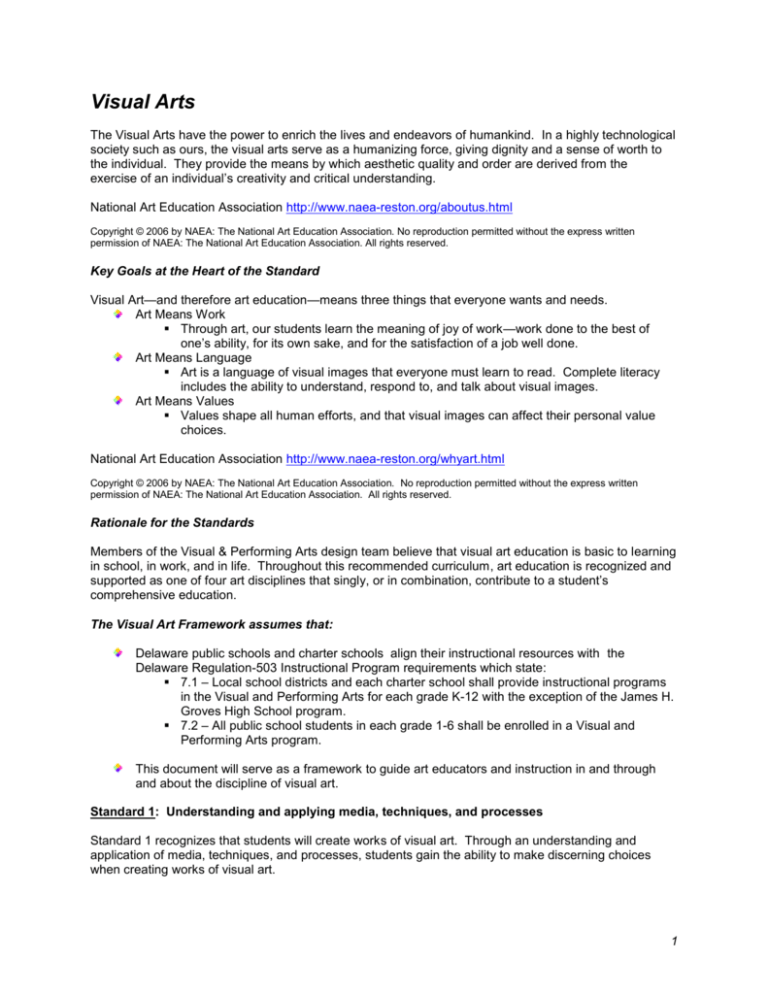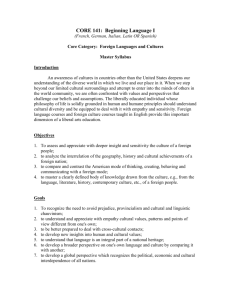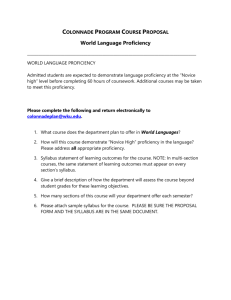
Visual Arts
The Visual Arts have the power to enrich the lives and endeavors of humankind. In a highly technological
society such as ours, the visual arts serve as a humanizing force, giving dignity and a sense of worth to
the individual. They provide the means by which aesthetic quality and order are derived from the
exercise of an individual’s creativity and critical understanding.
National Art Education Association http://www.naea-reston.org/aboutus.html
Copyright © 2006 by NAEA: The National Art Education Association. No reproduction permitted without the express written
permission of NAEA: The National Art Education Association. All rights reserved.
Key Goals at the Heart of the Standard
Visual Art—and therefore art education—means three things that everyone wants and needs.
Art Means Work
Through art, our students learn the meaning of joy of work—work done to the best of
one’s ability, for its own sake, and for the satisfaction of a job well done.
Art Means Language
Art is a language of visual images that everyone must learn to read. Complete literacy
includes the ability to understand, respond to, and talk about visual images.
Art Means Values
Values shape all human efforts, and that visual images can affect their personal value
choices.
National Art Education Association http://www.naea-reston.org/whyart.html
Copyright © 2006 by NAEA: The National Art Education Association. No reproduction permitted without the express written
permission of NAEA: The National Art Education Association. All rights reserved.
Rationale for the Standards
Members of the Visual & Performing Arts design team believe that visual art education is basic to learning
in school, in work, and in life. Throughout this recommended curriculum, art education is recognized and
supported as one of four art disciplines that singly, or in combination, contribute to a student’s
comprehensive education.
The Visual Art Framework assumes that:
Delaware public schools and charter schools align their instructional resources with the
Delaware Regulation-503 Instructional Program requirements which state:
7.1 – Local school districts and each charter school shall provide instructional programs
in the Visual and Performing Arts for each grade K-12 with the exception of the James H.
Groves High School program.
7.2 – All public school students in each grade 1-6 shall be enrolled in a Visual and
Performing Arts program.
This document will serve as a framework to guide art educators and instruction in and through
and about the discipline of visual art.
Standard 1: Understanding and applying media, techniques, and processes
Standard 1 recognizes that students will create works of visual art. Through an understanding and
application of media, techniques, and processes, students gain the ability to make discerning choices
when creating works of visual art.
1
In order to meet the standard, students will:
Select and use different media, techniques, and processes that are used to create works of art
Compare and contrast the different effects created by various two-dimensional and threedimensional works of art
Identify different media, techniques, and processes that are used to create works of art
Use selected two-dimensional and three-dimensional media to communicate ideas
Use media and tools in a safe and responsible manner
Demonstrate how a single medium or technique can be used to create multiple effects in works of
art
Describe how media and techniques are used to create two-dimensional and three dimensional
works of art
As a result, teachers should develop opportunities for learning that require students to demonstrate their
proficiency in the use of media, techniques, and processes in creating works of art. Following instruction
by certified art educators, students should be able to achieve proficiency at grade-level and at proficiency
levels of expectation.
Standard 2: Using knowledge of structures and functions
Standard 2 recognizes two broad areas of focus: the elements of art and principles of design; and the
motivations for making art.
In order to meet the standard, students will:
Identify the elements of art
Plan, design, and execute multiple solutions to challenging visual arts problems
Select and use the elements of art in works of art
Identify the principles of design
Analyze the elements of art
Evaluate works of art in terms of structure and function
Analyze the principles of design
Select and use the principles of design in works of art
Select and apply the knowledge of the elements of art and principles of design to convey ideas in
works of art
Analyze how the elements of art and principles of design applied through various media,
techniques, and processes produce different effects
As a result, teachers should develop opportunities for learning that require students to demonstrate their
communication proficiencies in a visual context. Following instruction by certified art educators, students
should be able to achieve proficiency at grade-level and at proficiency levels of expectation.
Standard 3: Choosing and evaluating a range of subject matter, symbols, and ideas
Standard 3 recognizes that the prospective content for works of visual art come from a variety of sources.
In order to meet the standard, students will:
Identify subject matter, symbols, and ideas in works of art
Integrate a variety of sources for subject matter, symbols, and/or ideas which best communicate
an intended meaning in works of art
2
Evaluate the sources for content to validate the manner in which subject matter, symbols, and
ideas are used in works of art
Select and use subject matter, symbols, and ideas to communicate meaning in works of art
Describe and differentiate the origins of specific subject matter, symbols, and ideas in works of art
Analyze how the use of subject matter, symbols, and ideas are used in works of art
As a result, teachers should develop opportunities for learning that require students to demonstrate
proficiency in choosing and evaluating prospective content for works of visual art. Following instruction
by certified art educators, students should be able to achieve proficiency at grade-level and at proficiency
levels of expectation.
Standard 4: Understanding the visual arts in relation to history and cultures
Standard 4 recognizes that visual arts have both history and specific relationships to various cultures.
In order to meet the standard, students will:
Identify historical and cultural characteristics of works of art
Describe how the arts and artists influence each other across history and cultures
Compare the purpose of works of art and design in history and cultures
Speculate on how history and culture give meaning to a work of art
Describe and differentiate the roles of artists in society across history and cultures
Describe how history and cultures influence the visual arts
Describe how the visual arts influence history and cultures
As a result, teachers should develop opportunities for learning that require students to demonstrate
proficiency in making historical and cultural connections about visual art. Following instruction by certified
art educators, students should be able to achieve proficiency at grade-level and at proficiency levels of
expectation.
Standard 5: Reflecting upon and assessing the characteristics and merits of their work and the
work of others
Standard 5 recognizes that reflection, assessment, and refinement are key steps in the process of
creating visual art.
In order to meet the standard, students will:
Discuss how individual experiences influence personal works of art
Identify ways the visual arts are used as communication
Describe personal responses to selected works of art
Analyze works of art to speculate why they were created
Evaluate the artist's intent and effectiveness in communicating ideas and emotions in works of art
Apply visual arts vocabulary when reflecting upon and assessing works of art
Describe how a work of art can convey a voice of one or a voice of many
As a result, teachers should develop opportunities for learning that require students to demonstrate
proficiency in evaluating their own work and the work of other artists. Following instruction by certified art
educators, students should be able to achieve proficiency at grade-level and at proficiency levels of
expectation.
3
Standard 6: Making connections between visual arts and other disciplines
Standard 6 recognizes that visual art is an integral component of a comprehensive education. The ability
to convey ideas visually and the skills necessary to understand, respond to, and talk about visual images
enable students to demonstrate complete literacy.
In order to meet the standard, students will:
Compare and contrast relationships between and characteristics of the visual arts and other
disciplines
Compare the use of technology, media, and processes of the visual arts with other disciplines
Describe and/or demonstrate how skills transfer between the visual arts and other disciplines
Describe how learning in the visual arts helps develop essential skills for the workplace
As a result, teachers should develop opportunities for learning that require students to demonstrate visual
literacy in all disciplines. Following instruction by certified art educators, students should be able to
achieve proficiency at grade-level and at proficiency levels of expectation.
4





